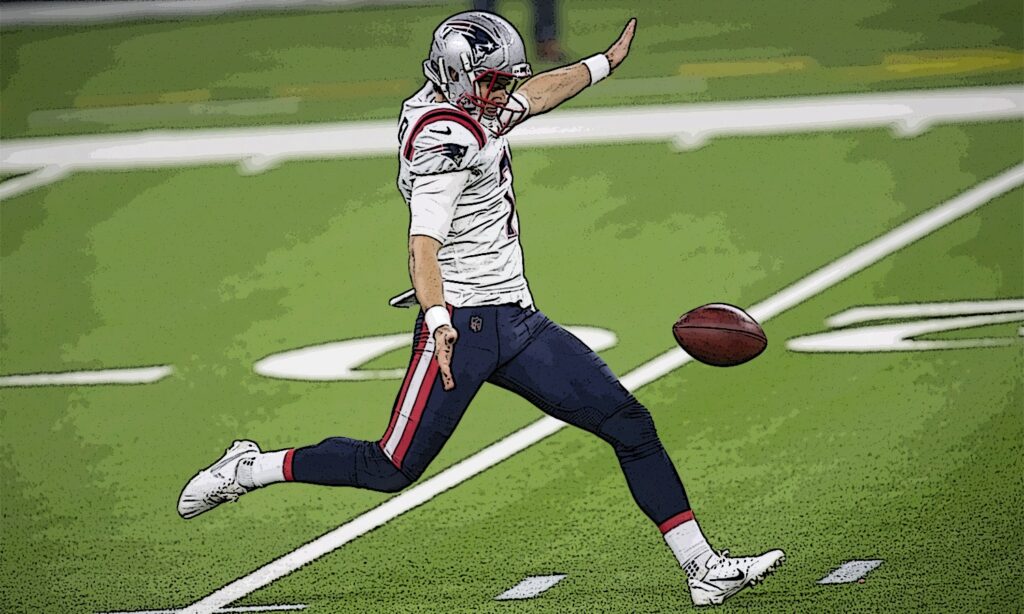In football, the goal for the offensive team is to extend their drive down the field until they score a touchdown or field goal.
They use a combination of running and passing plays to continuously achieve first downs.
To get the first down, they must gain a certain amount of yardage, typically 10 yards, within four attempts.
Once achieved, they refresh their set of downs.
Meanwhile, their opponents are trying to prevent them from advancing at every stage.
If the defending team stops them from reaching first down on the first three attempts, the attacking team is left with a few options.
If they deep enough in enemy territory, they can attempt a field goal for three points.
The next option is to “go for it” on fourth down and try to gain the necessary yards. But if they fail, they’ll turn the ball over on downs.
So, we’re left with the most likely option - punting the ball.
What is a Punt in Football?
A punt in football is a special teams play where the punter kicks the ball to the opposing team, typically on fourth down. The primary objective is to relinquish possession of the ball while strategically pinning the opponents deep in their territory. Punting is a key element in field position battles and defensive strategies within the game.
Following a punt return or fair catch, the opposing team switches on offense. They begin their own drive from the spot of return.
Note that penalties can be called such as false starts and holding that can affect the first down placement.
Depending on who’s at fault, the returning team may gain or relinquish additional yards following where the ball is downed.
Types of Punt Kicks
As described earlier, the objective on the punt is to kick the ball as close to the opponent’s end zone as possible, without it crossing over line.
If the ball crosses over the goal line, it will result in a touchback. This will give a more favourable position to the receiving team.
So, punters will use various techniques to achieve the best possible scenario.
Type of Punt Description
Regular Punt The standard punt, where the punter kicks the ball with a normal, end-over-end motion to achieve distance and hang time.
Coffin Corner Punt A precise punt aimed to land the ball near the opponent's corner of the field, making it difficult for the returner to advance the ball.
Rugby Punt A low, spiraling punt where the punter rolls out to one side before kicking the ball. This can help with directional punting and reducing return yardage.
Quick Kick A punt executed immediately after the snap, typically used as a surprise tactic to catch the defense off guard.
Pooch Punt A high, short punt intended to land the ball inside the opponent's 20-yard line, pinning them deep in their own territory.
Spiral Punt A punt where the punter attempts to generate a tight spiral for increased accuracy and distance.
Sky Punt A very high punt with a focus on hang time, making it difficult for the returner to find a good opportunity to return the ball.
Likely Outcomes on Punt Plays
Here’s a list of outcomes that can happen during a punt play. This will help give you an idea of what to expect on these plays.
Outcome Description
Fair Catch The returner signals for a fair catch, and the ball is declared dead where it's caught. The return team takes possession without risk of being tackled.
Touchback The punt travels into the end zone, and the returner opts not to attempt a return. The ball is placed at the 20-yard line for the opposing team's possession.
Return for Yardage The returner catches the punt and attempts to advance the ball up the field, gaining yardage for the return team.
Muffed Punt The returner mishandles the punt, but it's not recovered by the kicking team. The return team retains possession but may have worse field position.
Downed by Kicking Team The punt is downed by a player from the kicking team, typically near the opponent's goal line, pinning them deep in their territory.
Out of Bounds The punt goes out of bounds without being touched by the return team. The opposing team takes possession at the point where the ball went out.
Blocked Punt The defensive team successfully blocks the punt, preventing it from reaching the intended destination. This can result in a turnover or improved field position for the defense.
Fake Punt The punter initially lines up as if to punt but executes a pass or run play instead, attempting to gain a first down or score.
Punt vs Kickoff
While punt plays and kickoffs involve Special Teams on both sides, there are some major differences between them.
The punt is used by the team that is currently on offense when they fail to advance the ball far enough to earn a new set of downs (typically on fourth down).
Meanwhile, the kickoff takes place at the start of each half and following a touchdown or field goal.
Below is a comparative chart on what is allowed or not in each of the situations:
| Punt | Kickoff | |
|---|---|---|
| Blocking | It is possible to block the punter's attempt during a punt. | Not applicable, the opposing team cannot block the kickoff. |
| Fair Catch | Returner can signal for a fair catch anywhere on the field. | Returner can signal a fair catch anywhere before the 25-yard line. The play is considered a touchback and the ball is placed at the 25-yard line. |
| Touchback | Possible for punts when the ball is caught in the end zone. | Allowed on kickoffs caught in the end zone, or if a fair catch is signaled by the returner behind the 25-yard line. |
| Onside | Not applicable for punts. | Possible for kickoffs, often as a surprise play. |
| Out of Bounds Kick | The ball is spotted at the point where it crossed the sideline | Penalty results in re-kicking or receiving team gets the ball at a specified yard line. |
| Muffed Ball | The ball becomes live, and either team can recover it. | The ball becomes live, and either team can recover it. |
| Fake | Punting team can fake a punt and elect to run or throw the ball to attempt the first down. | Not applicable. |
Final Thoughts
Some of the most exciting plays in football result from the punting play.
While the typical outcome is a fair catch, touchback or return for short yardage - spectators hope for more.
There’s nothing like the returner finding a seam and running down the field for good yardage or a touchdown.
That will surely get the fans on their feet.
Heck, even a blocked punt or a bobbled catch will rile up the crowd.
If any should go wrong in the game, it’s when special teams are on the field - especially during the punt.
The likely reason is that there’s so much open space in these situations. Add the fact that the gunners are sprinting downfield at full speed to catch the returner.
You’ve got a recipe for the unexpected.






